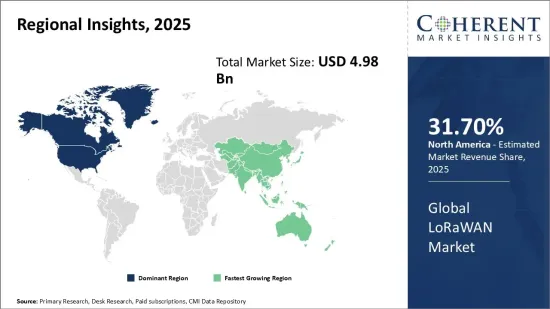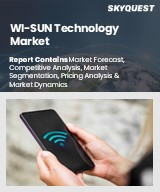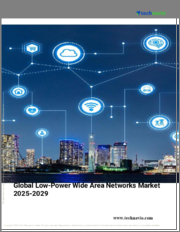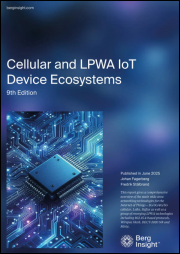
|
시장보고서
상품코드
1699588
LoRaWAN 시장 : 컴포넌트별, 전개 모드별, 지역별LoRaWAN Market, By Component (Hardware, Software, and Services), By Deployment Mode (Public, Private, and Hybrid), By Geography (North America, Latin America, Asia Pacific, Europe, Middle East, and Africa) |
||||||
세계의 LoRaWAN 시장은 2025년에는 49억 8,000만 달러로 추정되고, 2032년에는 400억 7,000만 달러에 이를 것으로 예측되며, 2025-2032년 CAGR 34.7%로 성장할 전망입니다.
| 보고 범위 | 보고서 세부정보 | ||
|---|---|---|---|
| 기준 연도 | 2024년 | 시장 규모(2025년) | 49억 8,000만 달러 |
| 실적 데이터 | 2020-2024년 | 예측 기간 | 2025-2032년 |
| 예측 기간 CAGR(2025-2032년) : | 34.70% | 가치 예측(2032년) | 400억 7,000만 달러 |

장거리 광역 네트워크(LoRaWAN) 기술의 도입으로 저소비 전력의 IoT 디바이스가 저소비 전력으로 장거리 접속 및 통신할 수 있게 되었습니다. LoRaWAN은 넓은 지리적 범위에 있는 자산에 비용 대비 효과적인 연결성을 필요로 하는 스마트시티, 공익사업, 산업 영역의 IoT 애플리케이션에 최적의 솔루션을 제공합니다. LoRaWAN 프로토콜은 낮은 데이터 속도와 장거리의 제한된 이동성으로 양방향 통신을 필요로 하는 애플리케이션에 매우 적합합니다. LoRaWAN과 같은 저전력 광역 네트워크(LPWAN)의 광범위한 전개는 확장 가능한 IoT 인프라의 세계 성장을 뒷받침하고 있습니다.
시장 역학 :
세계의 LoRaWAN 시장은 다양한 산업에서 IoT 애플리케이션의 채용이 증가하고 있는 것이 원동력이 되고 있습니다. LoRaWAN은 넓은 영역에 있는 자산에 비용 효율적인 연결성을 제공할 수 있기 때문에 스마트 시티, 스마트 미터, 산업용 IoT 사용 사례에 대한 채택이 진행되고 있습니다. 그러나 표준화의 결여와 데이터 레이트의 제한이 과제가 되고 있습니다. LoRaWAN을 5G 셀룰러 네트워크와 통합함으로써 IoT의 가능성을 최대한 발휘할 기회가 생기고 있습니다. 또한 특정 IoT 전개를 위한 기업에 의한 프라이빗 LoRaWAN 네트워크 개발은 유리한 기회를 제시합니다.
본 조사의 주요 특징
이 보고서는 세계의 LoRaWAN 시장을 상세하게 분석하고 2024년을 기준 연도로 한 예측 기간(2025-2032년) 시장 규모 및 복합 연간 성장률(CAGR%)을 제공합니다.
다양한 부문에 걸친 잠재적인 수익 기회를 밝히고, 이 시장의 매력적인 투자 제안 매트릭스를 설명합니다.
또한 시장 성장 촉진요인, 억제요인, 기회, 신제품 출시 및 승인, 시장 동향, 지역별 전망, 주요 기업이 채용하는 경쟁 전략 등에 관한 주요 인사이트도 제공합니다.
세계의 LoRaWAN 시장의 주요 기업을 기업 하이라이트, 제품 포트폴리오, 주요 하이라이트, 재무 실적, 전략 등의 매개변수를 기반으로 프로파일링하고 있습니다.
이 보고서의 인사이트를 통해 마케팅 담당자와 기업 경영진은 향후 제품 출시, 유형 업그레이드, 시장 확대, 마케팅 전술에 대한 정보를 바탕으로 의사 결정을 내릴 수 있습니다.
세계의 LoRaWAN 시장 보고서는 투자자, 공급업체, 제품 제조업체, 유통업체, 신규 참가자, 재무 분석가 등 이 업계의 다양한 이해관계자를 지원합니다.
이해관계자들은 세계의 LoRaWAN 시장 분석에 사용되는 다양한 전략 매트릭스를 통해 의사결정이 용이해집니다.
목차
제1장 조사의 목적 및 전제조건
- 조사 목적
- 전제조건
- 약어
제2장 시장 전망
- 보고서 설명
- 시장 정의 및 범위
- 주요 요약
제3장 시장 역학, 규제 및 동향 분석
- 시장 역학
- 영향 분석
- 주요 하이라이트
- 규제 시나리오
- 제품 출시 및 승인
- PEST 분석
- Porter's Five Forces 분석
- 시장 기회
- 규제 시나리오
- 주요 발전
- 업계 동향
제4장 세계의 LoRaWAN 시장 : 컴포넌트별(2020-2032년)
- 하드웨어
- 소프트웨어
- 서비스
제5장 세계의 LoRaWAN 시장 : 전개 모드별(2020-2032년)
- 퍼블릭
- 프라이빗
- 하이브리드
제6장 세계의 LoRaWAN 시장 : 지역별(2020-2032년)
- 북미
- 라틴아메리카
- 유럽
- 아시아태평양
- 중동
- 아프리카
제7장 경쟁 구도
- Bosch Group(Germany)
- Cisco(US)
- Orange SA(France)
- Comcast Corporation(US)
- Semtech(US)
- NEC Corporation(Japan)
- Tata Communications(India)
- AWS(US)
- Advantech(Taiwan)
- SKTelecom(South Korea)
- Actility
- Kerlink
- MachineQ(a Comcast Company)
- Microsoft
- STMicroelectronics
제8장 분석가 추천
- 운명의 원
- 애널리스트의 견해
- 일관된 기회 맵
제9장 참고문헌 및 조사 방법
- 참고문헌
- 조사 방법
- 출판사에 대해
Global LoRaWAN Market is estimated to be valued at US$ 4.98 Bn in 2025 and is expected to reach US$ 40.07 Bn by 2032, growing at a compound annual growth rate (CAGR) of 34.7% from 2025 to 2032.
| Report Coverage | Report Details | ||
|---|---|---|---|
| Base Year: | 2024 | Market Size in 2025: | USD 4.98 Bn |
| Historical Data for: | 2020 To 2024 | Forecast Period: | 2025 To 2032 |
| Forecast Period 2025 to 2032 CAGR: | 34.70% | 2032 Value Projection: | USD 40.07 Bn |

The introduction of Long Range Wide-Area Network (LoRaWAN) technology has enabled low-power IoT devices to connect and communicate over long ranges via low-power consumption. LoRaWAN offers an optimal solution for IoT applications in smart cities, utilities, and industrial domains that require cost-effective connectivity for assets located over large geographical areas. The LoRaWAN protocol is uniquely suited for applications that require bi-directional communication with low data rates and limited mobility over long-range distances. The widespread deployment of Low-Power Wide-Area Networks (LPWANs) like LoRaWAN is supporting the growth of scalable IoT infrastructure globally.
Market Dynamics:
The global LoRaWAN market is driven by the increasing adoption of IoT applications across various industries. The ability of LoRaWAN to provide cost-effective connectivity for assets located over large areas is boosting its adoption for smart city, smart metering, and industrial IoT use cases. However, lack of standardization and limitations in terms of data rates pose challenges. Emerging opportunities lie in integrating LoRaWAN with 5G cellular networks to realize the full potential of IoT. Also, the development of private LoRaWAN networks by enterprises for their specific IoT deployments present a lucrative opportunity.
Key Features of the Study:
This report provides in-depth analysis of the global LoRaWAN market, and provides market size (US$ Billion) and compound annual growth rate (CAGR%) for the forecast period (2025-2032), considering 2024 as the base year
It elucidates potential revenue opportunities across different segments and explains attractive investment proposition matrices for this market
This study also provides key insights about market drivers, restraints, opportunities, new product launches or approvals, market trends, regional outlook, and competitive strategies adopted by key players
It profiles key players in the global LoRaWAN market based on the following parameters - company highlights, products portfolio, key highlights, financial performance, and strategies
Key companies covered as a part of this study include Bosch Group (Germany), Cisco (US), Orange SA (France), Comcast Corporation (US), Semtech (US), NEC Corporation (Japan), Tata Communications (India), AWS (US), Advantech (Taiwan), SK Telecom (South Korea), Actility, Kerlink, MachineQ (a Comcast Company), Microsoft, and STMicroelectronics
Insights from this report would allow marketers and the management authorities of the companies to make informed decisions regarding their future product launches, type up-gradation, market expansion, and marketing tactics
The global LoRaWAN market report caters to various stakeholders in this industry including investors, suppliers, product manufacturers, distributors, new entrants, and financial analysts
Stakeholders would have ease in decision-making through various strategy matrices used in analyzing the global LoRaWAN market
Market Segmentation
- Component Insights (Revenue, USD Bn, 2020 - 2032)
- Hardware
- Software
- Services
- Deployment Mode Insights (Revenue, USD Bn, 2020 - 2032)
- Public
- Private
- Hybrid
- Regional Insights (Revenue, USD Bn, 2020 - 2032)
- North America
- U.S.
- Canada
- Latin America
- Brazil
- Argentina
- Mexico
- Rest of Latin America
- Europe
- Germany
- U.K.
- Spain
- France
- Italy
- Russia
- Rest of Europe
- Asia Pacific
- China
- India
- Japan
- Australia
- South Korea
- ASEAN
- Rest of Asia Pacific
- Middle East
- GCC Countries
- Israel
- Rest of Middle East
- Africa
- South Africa
- North Africa
- Central Africa
- Key Players Insights
- Bosch Group (Germany)
- Cisco (US)
- Orange SA (France)
- Comcast Corporation (US)
- Semtech (US)
- NEC Corporation (Japan)
- Tata Communications (India)
- AWS (US)
- Advantech (Taiwan)
- SK Telecom (South Korea)
- Actility
- Kerlink
- MachineQ (a Comcast Company)
- Microsoft
- STMicroelectronics
Table of Contents
1. Research Objectives and Assumptions
- Research Objectives
- Assumptions
- Abbreviations
2. Market Purview
- Report Description
- Market Definition and Scope
- Executive Summary
- Global LoRaWAN Market, By Component
- Global LoRaWAN Market, By Deployment Mode
- Global LoRaWAN Market, By Region
3. Market Dynamics, Regulations, and Trends Analysis
- Market Dynamics
- Impact Analysis
- Key Highlights
- Regulatory Scenario
- Product Launches/Approvals
- PEST Analysis
- PORTER's Analysis
- Market Opportunities
- Regulatory Scenario
- Key Developments
- Industry Trends
4. Global LoRaWAN Market, By Component, 2020-2032, (USD Bn)
- Introduction
- Market Share Analysis, 2025 and 2032 (%)
- Y-o-Y Growth Analysis, 2021 - 2032
- Segment Trends
- Hardware
- Introduction
- Market Size and Forecast, and Y-o-Y Growth, 2020-2032, (USD Bn)
- Software
- Introduction
- Market Size and Forecast, and Y-o-Y Growth, 2020-2032, (USD Bn)
- Services
- Introduction
- Market Size and Forecast, and Y-o-Y Growth, 2020-2032, (USD Bn)
5. Global LoRaWAN Market, By Deployment Mode, 2020-2032, (USD Bn)
- Introduction
- Market Share Analysis, 2025 and 2032 (%)
- Y-o-Y Growth Analysis, 2021 - 2032
- Segment Trends
- Public
- Introduction
- Market Size and Forecast, and Y-o-Y Growth, 2020-2032, (USD Bn)
- Private
- Introduction
- Market Size and Forecast, and Y-o-Y Growth, 2020-2032, (USD Bn)
- Hybrid
- Introduction
- Market Size and Forecast, and Y-o-Y Growth, 2020-2032, (USD Bn)
6. Global LoRaWAN Market, By Region, 2020 - 2032, Value (USD Bn)
- Introduction
- Market Share (%) Analysis, 2025,2028 & 2032, Value (USD Bn)
- Market Y-o-Y Growth Analysis (%), 2021 - 2032, Value (USD Bn)
- Regional Trends
- North America
- Introduction
- Market Size and Forecast, By Component, 2020 - 2032, Value (USD Bn)
- Market Size and Forecast, By Deployment Mode, 2020 - 2032, Value (USD Bn)
- Market Size and Forecast, By Country, 2020 - 2032, Value (USD Bn)
- U.S.
- Canada
- Latin America
- Introduction
- Market Size and Forecast, By Component, 2020 - 2032, Value (USD Bn)
- Market Size and Forecast, By Deployment Mode, 2020 - 2032, Value (USD Bn)
- Market Size and Forecast, By Country, 2020 - 2032, Value (USD Bn)
- Brazil
- Argentina
- Mexico
- Rest of Latin America
- Europe
- Introduction
- Market Size and Forecast, By Component, 2020 - 2032, Value (USD Bn)
- Market Size and Forecast, By Deployment Mode, 2020 - 2032, Value (USD Bn)
- Market Size and Forecast, By Country, 2020 - 2032, Value (USD Bn)
- Germany
- U.K.
- Spain
- France
- Italy
- Russia
- Rest of Europe
- Asia Pacific
- Introduction
- Market Size and Forecast, By Component, 2020 - 2032, Value (USD Bn)
- Market Size and Forecast, By Deployment Mode, 2020 - 2032, Value (USD Bn)
- Market Size and Forecast, By Country, 2020 - 2032, Value (USD Bn)
- China
- India
- Japan
- Australia
- South Korea
- ASEAN
- Rest of Asia Pacific
- Middle East
- Introduction
- Market Size and Forecast, By Component, 2020 - 2032, Value (USD Bn)
- Market Size and Forecast, By Deployment Mode, 2020 - 2032, Value (USD Bn)
- Market Size and Forecast, By Country, 2020 - 2032, Value (USD Bn)
- GCC Countries
- Israel
- Rest of Middle East
- Africa
- Introduction
- Market Size and Forecast, By Component, 2020 - 2032, Value (USD Bn)
- Market Size and Forecast, By Deployment Mode, 2020 - 2032, Value (USD Bn)
- Market Size and Forecast, By Country/Region, 2020 - 2032, Value (USD Bn)
- South Africa
- North Africa
- Central Africa
7. Competitive Landscape
- Bosch Group (Germany)
- Company Highlights
- Product Portfolio
- Key Developments
- Financial Performance
- Strategies
- Cisco (US)
- Company Highlights
- Product Portfolio
- Key Developments
- Financial Performance
- Strategies
- Orange SA (France)
- Company Highlights
- Product Portfolio
- Key Developments
- Financial Performance
- Strategies
- Comcast Corporation (US)
- Company Highlights
- Product Portfolio
- Key Developments
- Financial Performance
- Strategies
- Semtech (US)
- Company Highlights
- Product Portfolio
- Key Developments
- Financial Performance
- Strategies
- NEC Corporation (Japan)
- Company Highlights
- Product Portfolio
- Key Developments
- Financial Performance
- Strategies
- Tata Communications (India)
- Company Highlights
- Product Portfolio
- Key Developments
- Financial Performance
- Strategies
- AWS (US)
- Company Highlights
- Product Portfolio
- Key Developments
- Financial Performance
- Strategies
- Advantech (Taiwan)
- Company Highlights
- Product Portfolio
- Key Developments
- Financial Performance
- Strategies
- SK Telecom (South Korea)
- Company Highlights
- Product Portfolio
- Key Developments
- Financial Performance
- Strategies
- Actility
- Company Highlights
- Product Portfolio
- Key Developments
- Financial Performance
- Strategies
- Kerlink
- Company Highlights
- Product Portfolio
- Key Developments
- Financial Performance
- Strategies
- MachineQ (a Comcast Company)
- Microsoft
- STMicroelectronics
8. Analyst Recommendations
- Wheel of Fortune
- Analyst View
- Coherent Opportunity Map
9. References and Research Methodology
- References
- Research Methodology
- About us



















